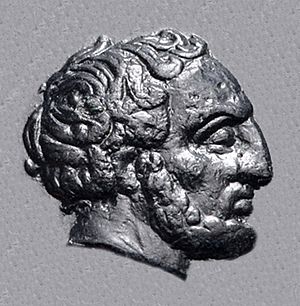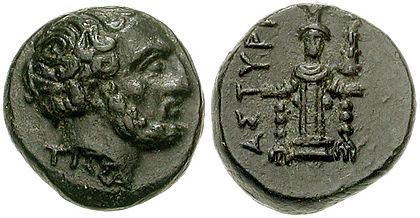Tissaphernes facts for kids
Quick facts for kids
Tissaphernes
|
|
|---|---|

Portrait of Tissaphernes (445 BC–395 BC), from his coinage. Most of his coins are inscribed ΤΙΣΣΑ ("TISSA") in Greek under his portrait, permitting identification.
|
|
| Satrap of Lydia | |
| In office 415 BC – 408 BC |
|
| Preceded by | Pissuthnes |
| Succeeded by | Cyrus the Younger |
| In office 400 BC – 395 BC |
|
| Preceded by | Cyrus the Younger |
| Succeeded by | Tiribazus |
| Personal details | |
| Born | 445 BC |
| Died | 395 BC (aged 50) Colossae, Phrygia, Persian Empire (modern-day Honaz, Denizli, Turkey) |
| Military service | |
| Allegiance | |
| Battles/wars | Battle of Cunaxa |
Tissaphernes (born 445 BC, died 395 BC) was an important Persian soldier and leader. He served as a Satrap (like a governor) of regions called Lydia and Ionia in the ancient Persian Empire. Most of what we know about his life comes from the writings of Greek historians like Thucydides and Xenophon.
Contents
Who Was Tissaphernes?
Tissaphernes was born into a powerful Persian family around 445 BC. His grandfather, Hydarnes, was a famous Persian general who led the elite Immortals army during King Xerxes' invasion of Greece. This background meant Tissaphernes grew up with connections to the highest levels of the Persian Empire.
Early Life and Rise to Power
In 414 BC, King Darius II gave Tissaphernes an important job. He was sent to stop a rebellion led by Pissuthnes, who was the Persian satrap of Lydia and Ionia. Tissaphernes was clever; he paid Pissuthnes' Greek soldiers to leave him. He also promised Pissuthnes that he would be safe if he gave up, but King Darius II did not keep this promise.
After this, Tissaphernes was told to stop another rebellion by Pissuthnes' son, Amorges. He also had to collect taxes from Greek cities in Asia Minor. Many of these cities were protected by Athens. To deal with this, Tissaphernes made a deal with Sparta, a rival of Athens. This alliance in 412 BC helped Persia take control of most of Ionia.
However, Tissaphernes often preferred to negotiate rather than fight. He was also in a rivalry with another Persian satrap, Pharnabazus. This made him less eager to act quickly against the Greeks. In 408 BC, King Darius II decided to support Sparta more actively. Because of Tissaphernes' slow actions, he was removed as a general. His power was limited to the region of Caria, and the war efforts in Lydia were given to Cyrus the Younger.
The Civil War and Battle of Cunaxa
When King Darius II died in 404 BC, his son Artaxerxes II became the new king of Persia. Tissaphernes discovered that Cyrus the Younger (the king's brother) was planning to harm Artaxerxes. Tissaphernes told the king about this plot, and Cyrus was arrested. However, their mother, Parysatis, helped Cyrus get pardoned, and he was sent back to his region. This event made Cyrus even more determined to become king himself.
Cyrus began to gather a large army. He pretended he was preparing to fight a tribe in the Taurus mountains called the Pisidians.
In the spring of 401 BC, Cyrus brought all his forces together. This army included about "Ten Thousand" Greek soldiers, led by Xenophon. Cyrus marched from Sardis without telling anyone his real goal. He managed to convince his Greek troops to join him by promising them great rewards. A Spartan fleet of 35 triremes (warships) helped open a path into Syria. A group of 700 Spartan soldiers also joined Cyrus.
However, Tissaphernes quickly warned King Artaxerxes II and gathered an army. Cyrus reached Babylonia before he met any resistance. In October 401 BC, the famous Battle of Cunaxa took place. Cyrus had 10,400 Greek hoplites (heavily armed foot soldiers), 2,500 peltasts (light infantry), and about 10,000 Asian soldiers.
Cyrus believed that winning the battle depended on defeating the king directly. He wanted the Greek commander, Clearchus of Sparta, to attack Artaxerxes in the center. But Clearchus refused. This allowed Tissaphernes, who was on the left side of the Persian army, to attack Cyrus's other forces. Cyrus himself charged at Artaxerxes but was killed. Tissaphernes claimed he was the one who killed Cyrus.
After Cyrus's death, his Greek soldiers realized they were deep inside a huge empire with no supplies, no money, and no strong allies among the Persian nobles. They offered to make their Persian ally, Ariaeus, king, but he refused. They then offered their services to Tissaphernes, but he also refused. The Greeks would not surrender to him.
Tissaphernes faced a challenge: he had a large army of strong Greek soldiers he couldn't easily defeat. He gave them food and, after some time, led them north towards their home. During this journey, he managed to separate the Persian general Ariaeus and his light troops from the Greeks. The main Greek officers foolishly accepted an invitation from Tissaphernes to a feast. There, they were captured, taken to the king, and executed. As a reward for his loyalty, King Artaxerxes gave Tissaphernes one of his daughters in marriage. He also made him governor of Lydia again and the main commander of the Persian army in Asia Minor.
Later Life and Death
After returning to Asia Minor, Tissaphernes attacked the Greek cities that had supported Cyrus. This led to a war with Sparta starting in 399 BC. In 396 BC, the Spartan king, Agesilaus II, led a campaign to free the Greek cities in Asia Minor. Tissaphernes suggested a ceasefire and promised to keep the peace. However, he immediately broke his promise when more Persian soldiers arrived. Agesilaus famously thanked Tissaphernes for making the gods favor the Greeks by breaking his word. Agesilaus then announced he would attack Caria. Tissaphernes gathered his troops to defend Caria, but Agesilaus instead successfully attacked the Persian region of Hellespontine Phrygia.
In 395 BC, Agesilaus announced that his next target would be the rich area around the Lydian city of Sardis. Tissaphernes thought that if Agesilaus really planned to attack Sardis, he wouldn't have said so. So, Tissaphernes believed Agesilaus would finally attack Caria and moved his troops there. But Agesilaus attacked Sardis, just as he had said he would.
Finally, Tissaphernes' downfall came when the Persian king listened to Pharnabazus II and the queen mother, Parysatis. Parysatis hated Tissaphernes because she blamed him for the death of her favorite son, Cyrus. A Persian official named Tithraustes was sent to kill Tissaphernes. Tissaphernes was tricked into going to Ariaeus's home in Colossae and was killed there in 395 BC.
Legacy
The Encyclopædia Iranica describes Tissaphernes in a balanced way:
Tissaphernes has been described, on the one hand, as impetuous and forthright, on the other, as a liar and treacherous deceiver (to Xenophon, he seemed "the supreme example of faithlessness and oath-breaking in the Anabasis"). Nevertheless, as one scholar has noted, "it is only fair to him to say . . . that in an epoch when disloyalty was becoming the normal he remained the most loyal subject of the two Kings whom he served". That Tissaphernes appeared to the Greeks as one of their most dangerous enemies and no doubt the model of an unscrupulous diplomat is not surprising; this bias has so deeply marked Greek traditions that it now seems nearly impossible to form a balanced judgment about him, especially as no Persian sources are available and the pertinent sections of the Lycian Xanthos stele are not yet understood.
This means that while Greek writers often saw him as dishonest, he was also very loyal to the Persian kings he served. It's hard to get a full picture of him because we don't have Persian writings from that time.
After Tissaphernes died, the region of Caria gained more independence under its own local rulers, though it was still part of the Achaemenid Empire.
Images for kids
-
Tissaphernes was Satrap of Lydia, including Ionia, under the Achaemenid Empire.
See also
 In Spanish: Tisafernes para niños
In Spanish: Tisafernes para niños



